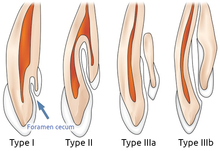Dens invaginatus
| Dens invaginatus | |
|---|---|
| Other names | Dens in dente, tooth within a tooth |
| Specialty | Dentistry |
Dens invaginatus (DI), also known as tooth within a tooth, is a rare dental malformation and a developmental anomaly where there is an infolding of enamel into dentin. The prevalence of this condition is 0.3 - 10%,[1] affecting males more frequently than females. The condition presents in two forms, coronal involving tooth crown and radicular involving tooth root, with the former being more common.[2]
DI is a malformation of teeth most likely resulting from an infolding of the
Signs and symptoms
DI is often asymptomatic with the affected crown showing minimal external deformity. Individuals with an affected tooth may complain of their tooth having an abnormal shape such as being wider mesio-distally or bucco-lingually.[4]
Teeth affected by this condition are at a higher risk for developing caries and periradicular pathology.[1] The thin layer of the infolding enamel could be chipped off easily, providing entrance for microorganisms into the root canal. This can cause abscess formation and displacement of dental structures (i.e. teeth).[5] Early diagnosis and prevention is very important for maintaining tooth vitality. Clinical features such as incisal notching or pronounced talon cusp on lateral incisors could hit at DI and should be investigated with radiographs.[4]
Cause
Cause of DI is unclear. However, there are several theories:
- Infection[1]
- Trauma[1]
- Growth pressure of the dental arches during odontogenesis[5][1]
- Rapid proliferation of the internal enamel epithelium invades the underlying dental papilla[5][1]
Diagnosis
During clinical examination,[6] abnormally shaped tooth can be observed. Teeth with this condition can have a conical shape or deep pit on the lingual side or have an exaggerated talon cusp.
Although examination may reveal a fissure on the surface of anterior tooth, radiographic examination is the way.[7] On a periapical radiograph, the invagination lesion will appear as a radiolucent pocket. It is usually seen beneath the cingulum or incisal edge. Larger lesions can appear as fissures. A radio-opaque could be shown. Pulp may be involved and the root canal could have complex anatomy. Two periapical radiographs are often required to make sure that it is not a masked lesion.
Cone beam computed tomography[8][9] (CBCT) is useful in diagnosing DI. It provides clinicians a detailed 3D image and could aid treatment planning. Feasibility of root canal treatment or apical surgery or other procedures could be assessed.
Oehlers' classification

- Class I - Partial invagination. It is limited to the crown of tooth. The lesion does not extend pass the cementoenamel junction (CEJ) or the pulp.[1]
- Class II - Partial invagination. It extends beyond the crown and CEJ. Pulp may be involved but remain within the root anatomy. There is no communication of the lesion with periodontal ligament (PDL).[1]
- Class IIIa - Complete invagination. It extends through root and communicates with PDL. It usually does not involve the pulp but can cause anatomical malformation.[1]
- Class IIIb - Complete invagination. It extends through the root and communicates with PDL through apical foramen. Pulpal anatomy may not be directly involved but can cause disruption to the dental anatomy.[1]
Histology
- No irregularities in the dentin below invagination[10]
- Strains of vital tissue or fine canals that communicates with the pulp could be found[10]
- Enamel lining irregularly structured[10]
- External and internal enamel have different structures[10]
Management
- Preventative treatment - e.g. oral hygiene instructions, fissure sealant[5]
- Intentional replantation[5]
- Root canal treatment with mineral trioxde aggregate[5][11][8][12]
- Periapical surgery with retrograde filling[5][11][6]
- Extraction[5]
References
- ^ S2CID 12853879.
- ISSN 0003-9969.
- ^ PMID 22919548.)
{{cite journal}}: CS1 maint: multiple names: authors list (link - ^ ISSN 0007-0610.
- ^ a b c d e f g h "What is dens invaginatus or dens in dente?". 3 Feb 2018.
- ^ PMID 20478470.
- ^ Radicular Dens Invaginatus: Report of a Rare Case https://www.hindawi.com/journals/crid/2012/871937/
- ^ PMID 22794224.
- PMID 25819658.
- ^ .
- ^ a b Satyaranjan Mishra, Lora Mishra, and Sujit Ranjan Sahoo (Nov 2012). "A Type III Dens Invaginatus with Unusual Helical CT and Histologic Findings: A Case Report". Journal of Clinical and Diagnostic Research.
{{cite journal}}: CS1 maint: multiple names: authors list (link) - PMID 24767572.
